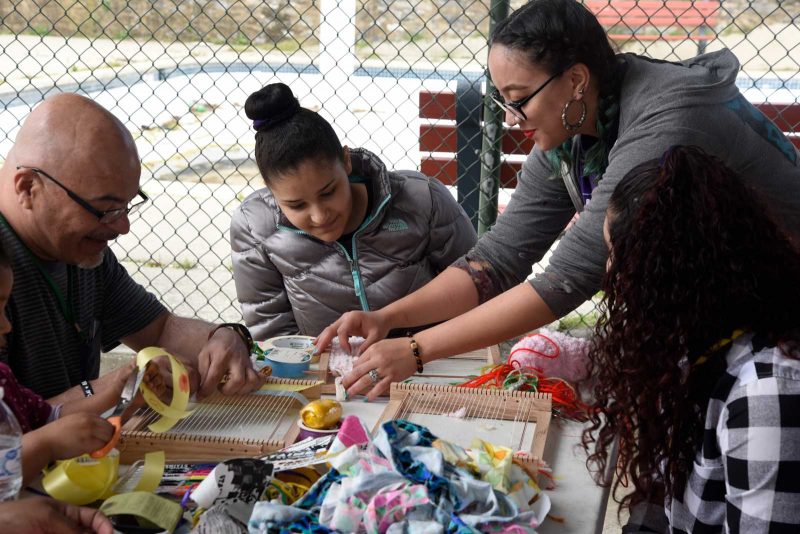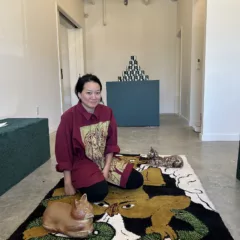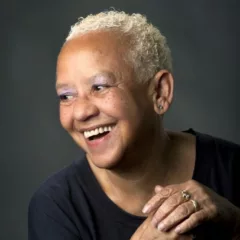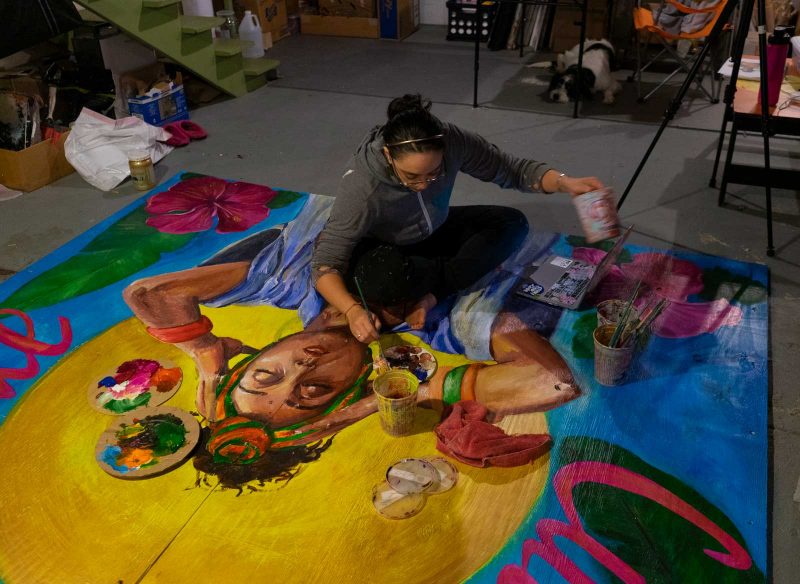
Salina Almanzar is a Puerto Rican/Domincan visual artist, community-based artist, art educator, writer, scholar, School Board Director and social justice warrior based in Lancaster, PA. In all that she does, Salina models the kind of thoughtful, compassionate and authentic creative that she and I both needed to see growing up. It is in the spirit of lifting up artists who challenge eurocentric artist stereotypes, that I reached out to Salina and asked to chat over cafecito.
Candy González: Can you give us a brief overview of who you are and all that you do?
Salina Almanzar: I usually describe myself as a visual artist and a community based artist… Outside of art stuff, I work at [Franklin & Marshall College] as a photo and printmaking tech and then I do a lot of adjuncting at Pennsylvania College of Art and Design and Drexel University. I am also a part of the school board for the school district of Lancaster–it’s an elected position.
CG: How did you come into art making? Tell us about the moment you realized that you wanted to be a professional visual artist?
SA: I’ve always been an artist. My mom has little sketches from when I used to draw the Rugrats like crazy… I remember when I was a junior in highschool, I was so convinced I was going to be a doctor. I was taking all these advanced science classes, and kind of hating them all except for anatomy because one way to study anatomy was by drawing it. The teacher was like, “you’re a really good artist, what do you want to do?”, and I was like, “well, I would like to be an artist but I’m not going to make any money”, and he said “I think you need to think more about that.” At first, I thought he was being naïve because I never saw any artists come out of my neighborhood [in southeast Lancaster] who made it… Then, my parents used to cater and had a food stand at our farmer’s market. I would always be sketching there and one day this guy came over and saw my drawings and said “oh, you’re an artist.” I responded, “no but I would like to be” and he said, “no, you are literally an artist; you are making art right now.” At F&M, where I went to college, I had already declared an English major and decided to take an art class just for fun. I fell in love with it and ultimately double majored.
CG: At its core, your work is an exploration and reconciliation of various intersecting identities, was this always the case? How did you come to embrace this narrative?
SA: In college, I knew I liked making work about bodies and it wasn’t until senior year that I felt I hit on something I could relate to… Initially, I was making feminist work that I thought had nothing to do with race and ethnicity because I didn’t know how to talk about it yet even though I was writing about it a lot. Then I took a year off to do a residency at a nearby college where I could essentially make work about whatever I wanted and that felt like a really good excuse to start diving into the question of how to use my writing more towards my [visual art]. It started with making busts, self-portraits that were three dimensional and then it almost naturally felt like I could start talking about all of my intersecting identities. I started researching and reading around colonization in Puerto Rico and Dominican Republic and it kind of became a way to connect to my family too.
CG: I see you as an artist who makes work rooted in the dissonance created by colonization and displacement, how do you stay grounded when things get intense?
SA: Thank you for saying that because the phrase that always comes up for me in this work is “ni de aquí, ni de alla” (neither from here nor from there), and I feel like I’ve lived into that my entire life… There’s a Bell Hooks essay on marginality that talks about the strength and power in the margins. So that is where I go… I also go to therapy and that is amazing. I feel that my work is also working through those messy, gross feelings because I am so often making work about how my language (English) is the colonizer’s language, and I see my not knowing Spanish well enough as another form of colonization. It’s made it really difficult to connect with my elders and there is so much lost there but I also feel a deep connection to my ancestors… It’s a lot but it’s also helped me think about where my place is in my family and my connection to the islands is.
CG: Who are your inspirations? How does their work inform your own?
SA: I go back and forth a lot. Amalia Mesa-Bains is one of them. She does these amazing ofrendas (offerings)… in my family, we have a bunch of little altars that we put up everywhere so I am really interested in that work. I weave in religious and cultural iconography, which are also really intertwined. Pepón Osorio is another person that I really admire because we both have a community-based and identity-based practice, and because some of his work straddles the line of public/private. I think that’s really interesting, also that it’s story based. I really like story-based work. Earlier [in our personal conversation], I mentioned Basquiat and Frida flippantly but I do really admire them. I love the way that Basquiat uses words and poems in his work. Oh, and Doris Salzedo is another one. I like the way she is able to distill a really powerful, often political, statement into a small object.
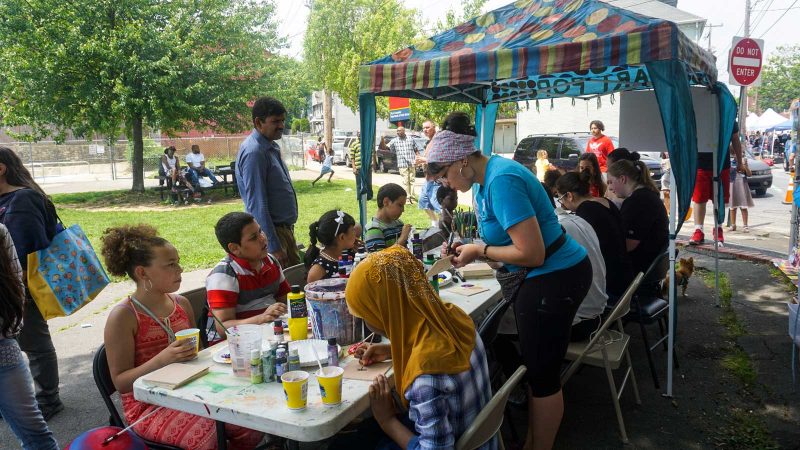
CG: What advice can you give artists who are maybe struggling to find and/or amplify their artistic voice?
SA: I love social media as much as I understand that it can be problematic. I joke that I found my identity on Tumblr and that’s real. If it feels safe for you, I think there are ways to cultivate community, especially if you live in a geographic space that doesn’t feel like a community. There are a lot of artists right now that I follow and I can talk to on Instagram to ask for advice… Being able to see the mistakes and being able to interact with the real person is really important. I find reading helpful, especially if it’s a subject I will make work about. I try to surround myself with that subject. When I am feeling uninspired, I watch a lot of Art21 videos. It helps get me out of my funk and makes me anxious to get back into the studio.
CG: In your life, you wear many hats, that of educator, administrator and visual artists, how do you balance all that you do?
SA: I am still working on this. There is a small part of me that feels like there is no balance. Seriously though, doing more internal work and therapy helps. I’ve been going for two and a half years and it has been amazing. Because the way my anxiety manifests is with imposter syndrome so I don’t feel like I am doing enough, having someone to share that with and having them tell you “you are doing enough” is really important. Since starting therapy, I’ve experienced the first time where I felt like I knew when to say ‘no’…I’m getting better at picking and choosing opportunities.
CG: In 2017, you ran and were elected to the School Board of Lancaster. Can you share with us what led to your decision to run for school board? Can you share a lesson you’re taking away from your experience?
SA: I hate to say that Trump being elected was the catalyst for this but it was. At the time I felt like, “I need to do something to protect people” and especially those in public schools… I’ve always had a deep, deep appreciation for education and I felt that I could do good work on the school board. At the time there was an open seat. I was the youngest person running and people were really critical and speculated that I was using that opportunity as a stepping stone, and it just disgusts me. That is a lesson that I learned, that people see our education system as something that fixes everything but people don’t perceive the school board as important enough for people to want to run, to actually improve the school system. It’s also been a lesson in how our electoral politics work in general, how unjust they are.
CG: One thing that I admire about you, is your dedication to building community through art making. Can you tell why this is such an important part of your practice and what you’ve learned as a community artist?
SA: Community work is important to me in part because of the culture I come from, where my win isn’t just my win. When systems fail, when government fails, like it always inevitably does, we’ve got each other… I am also very interested in people’s stories, especially in a small place like Lancaster where, even though it is small, we still have a tendency to divide ourselves. Art making is a way for me to make real the stories of people who experience these divides. Art making has been a way of revealing what is already there. I also go back to the idea of being the person that I needed to see when I was a kid.
CG: Do you listen to music when you are working in the studio? If so, what are you listening to these days?
SA: Yes. I used to get in trouble for having the music too loud in the studio. Lately, I have been listening to a lot of R&B. So, Ari Lennox is someone I am listening to a lot. I’ve had WAP on repeat. Tierra Whack, José James and Erykah Badu are people I’ve been listening to a lot as well, but then I’ll go funky and listen to Of Montreal which is one of my favorite bands.
